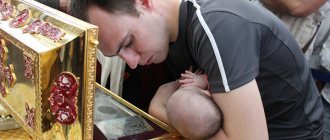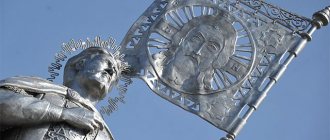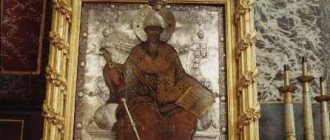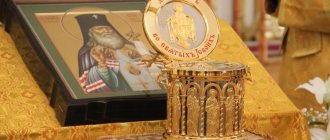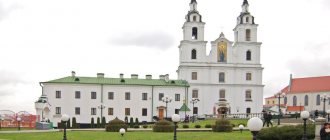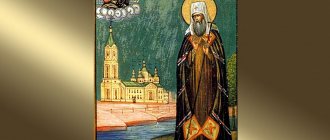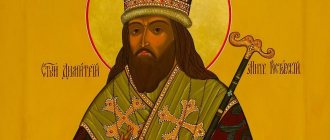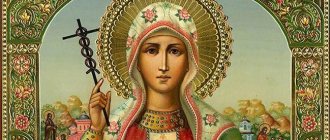It is believed that the relics of saints in temples, churches, and monasteries have a beneficial effect on the flock. They help those suffering adversity, calm the suffering and heal the weak. If the news spreads across Moscow, and even more so in a provincial city, that the relics of a saint have been brought, then people flock to see them, like a pop star. Such a relic is the pride of any temple. And if holy relics are suddenly found, then this event becomes epoch-making. Today you will find out what the relics of holy wonderworkers in churches and monasteries actually are. What do true Christians worship?
Old Believer Reciter Commissioner Qatar claims that in his personal library there is a book “Curiosities of Traditions”, author L. Lalande. It has been declared prohibited by the Catholic Church. It was confiscated and mercilessly destroyed throughout the 19th century. It is considered non-existent today. But the ancestors of Bogumil Katara saved one copy.
Who is L. Lalande - author of the book “Curious Traditions”
Before talking about why the book did not please the churchmen, it is worth saying a few words about the author.
Today you will not find any mention of L. Lalande and his biography. They erased a person from history. Meanwhile, this is a famous person of his time. His name is written in golden letters in astronomy.
Joseph Jerome Lefrançois de Lalande (French Joseph Jérôme Lefrançois de Lalande; July 11, 1732, Bourg-en-Bresse, near Lyon, France - April 4, 1807, Paris, France) - French astronomer, hiding behind the pseudonym L. Lalande.
At the end of the 18th century, Lalande observed 50 thousand stars. They were placed in a catalog known under the title “French Celestial History” (French: “Histoire c;leste fran;aise”). His name is included in the list of the greatest scientists of France. You can see this list on the first floor of the Eiffel Tower. He was even a foreign honorary member of the St. Petersburg Academy of Sciences.
As you can see, L. Lalande is both a serious scientist and an authoritative person. This one can be trusted.
The relics of saints in churches and monasteries are profanation
Why did L. Lalande’s work end up in the index of books banned by the church? Everything is banally simple. With the scrupulousness characteristic of astronomers, he examined all the holy relics kept in the monasteries and churches of Europe. And he came to a conclusion that was shocking even to himself. The relics of saints in churches and monasteries are, most often, pure profanation.
L. Lalande wrote his famous book during the time of Napoleon. At that time, freethinking flourished in France and the authorities did not really honor the Catholic Church. “Curiosities of Traditions” became a real bomb.
It turns out that European churches and monasteries store:
- 2 heads, 17 arms and legs and 5 torsos for St. Andrew the First-Called,
- 20 bodies and 26 heads of Saint Julian,
- 3 intact mummified prophet Elijah,
- 9 mummies of Apostle Luke,
- 18 heads and 12 hands of Saint Philip,
- 15 hands of John Chrysostom,
- 13 hands of Saint Sebastian,
- 30 bodies of St. Gregory,
- 2 torsos, 8 heads, 6 arms and legs of Saint Anne,
- 30 bodies of St. Gregory,
- 30 bodies of Saint Pancras.
- 11 index fingers, 7 jaws, 9 hands and 7 heads of John the Baptist.
In honor of the discovery of each head of the Baptist, special holidays were established in the Orthodox and Catholic churches.
Multi-headed relics of St. John the Baptist in Syria
There is no need to talk about minor saints. Their limbs and relics found peace and veneration in incredible quantities throughout Europe. At least take it out by truck.
Sometimes things reach the point of complete absurdity. In one of the monasteries in Syria they keep the child's head of John the Baptist. And according to the biblical text, King Herod executed the already adult John. Where does a child's head come from then? Has one disappeared as unnecessary and another has grown? To such questions, the monks answer that this is a miracle of God. And you can only believe in it, and not talk about it.
Monks can be understood. After all, it is a rare monastery that owns such a miracle – the child’s head of John the Baptist. More than two dozen Syrian monasteries and temples can boast of the heads of the adult John. But according to Christian legend, the body of the Baptist was burned along with his severed head.
In his book, Lalande is amazed at the abundance of bodies and heads of the holy wonderworkers. He counted 3 bodies and 4 heads in Benedict, 11 bodies in Erasmus, 6 bodies in Dorothea, 4 bodies and 8 heads in Stephen, 7 bodies and 10 heads in William, 2 bodies, 4 heads and 63 fingers in Jerome, and in Julian – 20 bodies and 26 heads and so on in the same spirit.
“You know, the list is so huge that I am not able to submit it in full. And therefore I decide to publish L. Lalande’s book “Curious Traditions” in electronic version on the pages of the world wide web. Of course, it will take time, but it will be worth it,” Qatar assures.
They also surprise gullible believers with the relics of the rooster that crowed for Peter, the bones of the cows that the Egyptian pharaoh dreamed of, the skeleton of the donkey on which Jesus rode into Jerusalem... There is no end to this wonderful list. For example, how do you like the vessel with the sweat of St. Michael, collected after his struggles with the Devil. Or the sneeze of the holy spirit, the box with the last breath of Jesus...
Are holy relics always incorruptible?
No not always. The decay of a dead body is a natural process established by God, which is not a sign of the death of the soul of the deceased. Also, the incorruptibility of the remains does not mean that they are holy. Archbishop Veniamin (Krasnopevkov-Rumovsky) notes that in some cases, the incorruption of the body can be evidence of God’s wrath and a consequence of excommunication from the Church.
However, the bodies of sinners, although they are intact, are ugly, black, and bloated. The incorrupt relics of saints, on the contrary, as a rule, exude a fragrance; they are not offensive to the eye. Metropolitan Macarius (Bulgakov) explains the incorruption of holy relics
“by their removal by the miraculous power of God from the universal law of corruption, as if as a living lesson to us about the future resurrection of bodies.”
The Monk Ambrose of Optina said the following:
“In fulfillment of the words of the Lord: you are dust and to dust you will return (Gen. 3:19), - and in the holy relics a certain part is given over to decay: either the fingers of a hand or a toe, or something else” (“Letters”)
Hieromartyr Alexander Trapitsyn notes that in some cases, remains can be well preserved simply because of favorable climatic conditions. The bodies of truly holy people often began to decay after death, but this process was stopped by Divine power:
“This stopped decay in mortal remains with the flow of miracles and healings from them serves as the basis and motivation for believers to reverently honor them.”
In any case, the main arguments in favor of a person’s holiness are his pious life and the miracles that occur through his prayers. The incorruptibility of the relics is only an additional argument.
So, not all incorruptible remains are holy and the relics of the righteous do not always remain incorruptible. However, for many centuries there was a belief among the people that holy relics were certainly intact. This misconception was used by the godless Soviet authorities in anti-religious propaganda. Many public dissections of holy relics were carried out. Many of them turned out to be bones, which was contrary to people's expectations.
Holy relics in Moscow and Athos
You should not think that in Russia things are somehow different with the relics of holy wonderworkers and saints. The Orthodox Church keeps one head of John Chrysostom in the Epiphany Cathedral in Moscow, and the second in a monastery on Mount Athos.
This is what the magazine “Revolution and the Church” wrote in 1920 in the “Report of the VIII Department of the People’s Commissariat of Justice to the Congress of Soviets on the opening of the relics”:
“On October 22, 1918, when registering the liturgical property of the Alexander-Svirsky Monastery, Petrozavodsk province, in a cast shrine weighing more than 20 pounds, instead of the “incorruptible” relics of Alexander Svirsky, a wax doll was discovered.”
Then this message caused a storm among church officials and parishioners. People became interested in what was kept in other church crayons and caskets for relics. Special commissions were created in a number of provinces. They, in the presence of experts and representatives of the clergy, conducted 63 openings of the repositories of holy relics. Numerous falsifications on the part of clergy were revealed.
Silver tombs, often decorated with precious stones, contained, at best, bones that had turned to dust. More often - imitation of bodies in the form of iron frames wrapped in fabric. Or pieces of cotton wool and flesh-colored pieces of cardboard.
Where are the relics of Alexander Nevsky actually found?
On September 12, the Russian Orthodox Church celebrates the day of the transfer of the relics of the Holy Blessed Grand Duke Alexander Nevsky. This holiday is a revival of a historical date established in the 18th century. All Russian emperors supported this annual event, which was interrupted only in Soviet times. It is believed that the shrine, moved to St. Petersburg by Peter I, was symbolically laid at the foundation of the young capital. But the story of the transfer of the relics of Alexander Nevsky to the city on the Neva became another milestone in the dramatic fate of his remains. And its researchers are increasingly convinced that we have irretrievably lost them. Let's trace the posthumous path of the holy prince.
Photo: neizvestniy-geniy.ru
Finding Sainthood
During his fourth trip to the Horde, Alexander Nevsky fell ill and fell ill on the way back. Having adopted the schema under the name Alexy, he died on November 4, 1263 in Gorodets Volzhsky. His body was brought and laid in the Bogolyubsky Monastery. Metropolitan Kirill of Vladimir with many clergy and people, informed of his death, arrived here from Vladimir. Taking the coffin with the body of the noble prince, they honorably carried it to Vladimir, where they performed a funeral service and buried the remains of the prince in the Church of the Nativity of the Blessed Virgin Mary in the monastery. Until the middle of the 16th century, this monastery was considered the first monastery in Rus', the “great archimandrite.”
Photo: sobory.ru
In the Laurentian Chronicle for 1377, Alexander Nevsky was first called a saint. In 1381, in Vladimir, his relics were discovered: “The great bishop... the great autocrat, having excavated the place, went to the many healing all-holy relics of the saint, placed in everyday life, having found them incorruptible and intact from many years... you will place it in the race at the top of the earth in the Church of the Most Pure Mother of God, in it must have been before.”
"Miracles" in the monastery
On May 23, 1491, the Mother of God Nativity Monastery suffered from a fire: “A lot of monks and lay people with a lot of property gathered in that church, i.e., the Nativity (during the fire), and everything burned out inside that church.” But, as the handwritten life of St. Alexander Nevsky, his relics were miraculously preserved in the fire. The same document also testifies to other miracles occurring at the shrine with the remains of the Grand Duke: the healing of the sick, the blind, and the possessed. In 1552, Ivan the Terrible stayed in Vladimir.
During a prayer service in front of the relics of St. Alexander, the sore hand of Tsar Arkady’s close associate healed.
The idea of the prince’s holiness became increasingly stronger in the Vladimir lands, and more and more new legends about the posthumous appearances and miracles of the prince were formed here. When the construction of the Alexander Nevsky Lavra in the new capital was just beginning, the image of Saint Prince Alexander Nevsky had already become very famous. Numerous icons with his face were painted, his images were placed on triumphal buildings in honor of the victories of the Russian army. And Peter I piously believed that Alexander Nevsky, as the Pleasant of God, who was the constant guardian of the local region from external enemies, would remain the most reliable defender and guardian of the newly built St. Petersburg.
Icon of the Holy Blessed Prince Alexander Nevsky. Photo: ikonaspas.ru
Travel from Vladimir to St. Petersburg
In May 1723, while in the Alexander Nevsky Lavra, Peter the Great “commanded that the relics of Alexander Nevsky located in the Vladimir Nativity Monastery be transferred here.” The ritual of transferring the relics was developed in the smallest detail. A special ark was made for the reliquary with the relics. August 11, 1724 was the day the transfer of the relics began. On this occasion, services were held in all churches.
But the impression was that Alexander Nevsky did not want to leave Vladimir.
The constructed ark did not fit through the monastery gates, so the wall had to be dismantled. When the ark reached the bridge over the Vorsha River, the crossing collapsed. They say that in this way Alexander Nevsky showed his attitude towards the move. But his movement continued anyway.
From Novgorod the relics were to travel by water on a specially prepared yacht to St. Petersburg. Peter I himself rode out to meet the holy relics on a galley at the mouth of Izhora. He himself carried them from the yacht to the galley, ordered those accompanying them to sit on the oars, and he himself controlled the steering wheel. When the sovereign's galley landed on the shore, Peter I himself picked up the ark under cannon and weapons fire and on August 30, 1724, moved it to the Alexander Nevsky Monastery.
“The transfer of the relics of the blessed prince St. Alexander Nevsky by Peter the Great to St. Petersburg.” Photo: ru.wikipedia.org
In honor and memory of the transfer of the holy relics of Prince Alexander Nevsky, celebrations and festivities lasted three days. Peter I ordered annually on August 30 (the victorious end of the Northern War, which lasted 21 years) to celebrate the transfer of the relics of the blessed prince in all Orthodox Russian churches. At the same time, he intended to establish an order in honor of Alexander Nevsky, but this intention was fulfilled in 1725 by his wife, Catherine I.
Soviet "life" of the relics
With the closure of the Trinity Cathedral in the Lavra in 1922, the reliquary with the relics of the prince was opened and 12 small bones of different colors were found (meaning from different relics). In addition, two identical bones of one right leg were discovered. The seized silver shrine was transferred to the Hermitage, where it remains to this day, and its contents were stored in the Museum of the History of Religion and Atheism, which opened in the Kazan Cathedral. But the image of the Grand Duke was also required by the Soviet government.
Opening of the relics of Alexander Nevsky, May 1922. Photo: smolbattle.ru
In 1938, the film “Alexander Nevsky” was released by director Sergei Eisenstein and screenwriter Pyotr Pavlenko. Its creators received the Stalin Prize. The leader himself, in his speech on July 3, 1941, called Nevsky one of the heroes of Russian history. The following year, a new Soviet military order of St. Alexander Nevsky was established, which was received by 42 thousand Red Army commanders during the war years. In the newly opened Trinity Cathedral in 1943, a place for worship in memory of Nevsky was set up, decorated with red banners. And on June 3, 1989, the relics (or whatever remained there) of St. Alexander Nevsky returned to the cathedral.
In Vladimir, the “relief with a particle of relics” along with other property was transported to the Trinity Church, where the last rector of the Nativity of the Mother of God Monastery, Archimandrite Afanasy (Sakharov), went to serve. On October 2, 1923, it was moved to the Assumption Cathedral, which belonged to the Renovationists from July 1923 to April 1927. Currently, a particle of the relics of St. Alexander Nevsky from it resides in the Assumption Cathedral, in a gilded shrine on the north side of the central nave. But whose actual remains are these, only God knows!
Cancer with a particle of the relics of Alexander Nevsky in the Assumption Cathedral. Photo: lubovbezusl.ru
Holy relics of Abraham the martyr made of cotton wool
The offices of the patriarchates also call for public examination and inspection of holy relics. In order to “eliminate any reason for mockery and temptation,” the crayfish are cleared of such items as a sardine box, brooches with the inscription “Shura” and similar debris. The “discovery” of these very items in the crayfish was documented in the autopsy reports. They are signed by representatives of the clergy.
As an example of the above, Bohumil Qatar cites the following protocols:
“Abraham martyr, Vladimir February 12, 1919.
After removing the covers, cotton wool of fresh origin was discovered, in which lay a group of bones of more than one person, at least two. One bone differs in appearance from all the others in its freshness, due to its density and whiteness. There is cotton wool inside the skull.”
Holy relics of Artemy Verkolsky made of nails and bricks
“The relics of Artemy Verkolsky, Arkhangelsk province. December 20, 1918
A coffin divided into 3 parts. In the first part there is cotton wool. In 2nd church vestments. In the 3rd, a small red chest, tied with a cord and sealed with the seals of the Verkolsky monastery. Upon opening the chest, the following was found: ordinary coal, burnt nails and small bricks. There are no signs of bones.
The monks and Archimandrite Ioannikis were present at the autopsy. Some monks, saying, this is how we have been deceived until now, began to take off their monastic clothes and, throwing them into the corner of the church, said: “Enough of fooling us.” ... One of the village women, when she saw what was found instead of the relics, said: “I, a fool, came here last year. And when she approached the shrine, she trembled all over with fear, thinking that there really was an incorruptible saint here. But look here, what rubbish has been put in place of the saint.”
How are real relics distinguished from fake ones?
The ancient practice of dividing holy remains into particles (to position new temples and protect against looting) led to the appearance of a large number of fake relics. Getting rich on fake shrines continues to this day. Archpriest Andrei Boytsov notes:
“The Russian Orthodox Church is carrying out professional work to study the authenticity of the relics of saints coming from the West... Employees of the Center for the Study of Orthodox Shrines have prevented hundreds of cases of fake shrines getting into churches.”
The priest warns against buying “pieces of relics” on the Internet and at flea markets. If an Orthodox Christian venerates counterfeit relics out of ignorance, then there is nothing wrong with that. After all, the main thing is the faith with which we ask God and the saints for help. “According to your faith, be it done to you” (Matthew 9:29).
An expert in the study of Orthodox shrines, Mikhail Arteev, points out that genuine shrines are always well documented and “do not appear out of nowhere.” Reliquaries are sealed by bishops and opened only with their participation. The division of holy remains is certainly recorded in documents. In some cases, special studies and examinations are carried out. Mikhail adds that only particles of reliable relics are sewn into antimensions.
Relics of Saints Prince Constantine and Shura
“Prince Constantine, his “children” Mikhail and Theodore, mother Irina, Murom. February 10, 1919
Four bags of bones. Cotton wool and rags, which are shaped like breasts. But when opening the bag in which Irina’s head was supposed to be located, it turned out to be a skull with a collapsed middle, stuffed, like the others, with cotton wool and rags. At the bottom of the shrine, under the heads of the figures on the left side, a bone brooch with the inscription “Shura” was found.
“Tikhon of Zadonsk, Zadonsk. January 28, 1919
Scull. A dried part of the tibia that turns into powder when touched. Cardboard painted flesh color. Falsification of arms and legs using cotton wool and cardboard. There is a slot in the glove in which flesh-colored cardboard is inserted, and the believers touch it. Ladies' stockings, boots, gloves. Instead of a chest there is an iron frame.”
Holy relics of Sergius of Radonezh, moth-eaten
“Sergius of Radonezh, Sergiev, Moscow province. April 11, 1919
Moth-eaten rags, cotton wool, dilapidated human bones, a mass of dead moths, butterflies, larvae. In the skull, in wired paper of recent origin, there is light brown-reddish hair.
“Kirill Novoezersky, Belozersk February 1919
A doll depicting a person, with the shape of a human face and with all its parts, such as the nose, chin, etc. It seemed that under this cover there really was a person. Under the cover, in reality, only a pile of bones was found. Moreover, some, such as the femur, the back of the head box, retained their shape, but all the other bones turned into powder. The skull contains two copper coins from 1740 and 1747.”
Rotten relics of St. Dmitry of Rostov
"Dmitry Rostovsky, Rostov. April 26, 1920
A skeleton that has retained some of the skin on the torso and limbs in a decayed form, turning to dust. There is cotton wool in the skull. The appearance of the bone remains is no different from the ordinary remains of a rotten corpse.”
“Pitirim Tambovsky, Tambov province. February 29, 1919.
Metal doll, box-case in the shape of a human body and the length of an average person's height, folded, opening in the front and in the middle in both directions. There are bones covered in wax inside. A wax cast of the head containing small fragments of the parietal, occipital and temporal bones.”
“Mikhail Tverskoy, Tver May 18, 1919
Under a large number of covers, a white schema was discovered and there were bones in it in a disorderly manner. The skull lies with the lower jaw separated, the vertebrae along with the ribs. Those around the raku were embarrassed. There are circles of parishioners around the temple. The old peasant said: “But I believed and went to worship for 18 years.”
All these and many similar protocols, let me remind you, were signed by representatives of the Patriarchal Office.
Methods of storing holy relics
What do the relics of saints look like? These can be either dried bodies or skeletons of the righteous, or their individual fragments. To store and display for veneration a fully preserved body or voluminous relics, a beautifully decorated wooden or metal coffin – a reliquary – is used. It may also contain various relics associated with the saint (clothes, cross, etc.).
Fragments of relics are stored in small boxes (reliquaries) or vessels (reliquaries). The reliquary with holy remains is placed under the altar of an Orthodox church during its consecration by the bishop. Reliquaries are often attached to icons. The role of a reliquary can be performed by a bishop's panagia (breastplate of the Mother of God), a priest's cross and other attributes of the clergy. In the old days, fragments of relics were often carried on themselves by laymen, using chest reliquaries.
In the altar of an Orthodox church, on the throne lies an antimension - a scarf with a piece of relics sewn into it. It is known that the first Christians celebrated the liturgy at the tombs of martyrs. Therefore, the modern Church, following the ancient sacred custom, celebrates the liturgy on the antimension with a particle of the holy remains.
How the relics of saints multiplied in monasteries and churches
In the Middle Ages, European alchemists and pharmacists believed in the healing properties of powders prepared from mummified remains. and for the production of various tinctures and elixirs. It was believed that such a drug almost bestows eternal youth. Tinctures on the remains of saints, of course, were especially valued.
Thus, the trade in relics became widespread. She brought in serious income. How could fake relics not appear here? The temptation to replace genuine relics with fake ones was great.
This is what the Commissioner of Qatar says about false relics of saints:
“Well, reader, did you learn a lot of unexpected things today? But most of the saints listed are again in use in the church, and they call you to bow to them. Of course, faith is your personal matter and it’s not for me to tell you. But you are also dealing with a man strong in the old faith, which knew no bones or rags. And even more so worship them.”
So the display of the relics of saints in monasteries and churches around the world is still a spectacle. Both in Moscow and in the Vatican. No matter the relics of a saint, there is no certainty about their authenticity.
Ivan Ivanovich A.
What are the relics of saints?
A person new to Orthodoxy may have a question: “What are the relics of saints?” This is the name given to the remains of God’s righteous people, revered by the Church. In Church Slavonic, the concept of “power” is used in relation to the body or ashes of any deceased person. The remains of the righteous are usually called holy (or honest) relics.
Relics of St. Nicholas the Wonderworker in Bari (Italy)
The concept of “power” comes from the word “might” (strength). In ancient times, the source of a person’s natural vitality was considered to be his bones, not his flesh. The remains of people, as a rule, are represented by bones.
